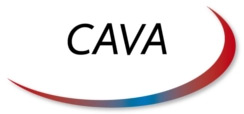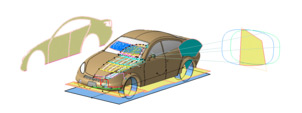|
 |
| "CATIA V5 - Automotive Extensions – Vehicle Architecture" (CAVA) resulted from a joint project by Transcat PLM and the German car manufacturers. International rules, norms and standards are provided during the entire design process - from the concept phase to the homologation. CAVA is a feature-based and associative technology integrated with CATIA V5. |
| |
| CAVA - Solutions for car design and legal compliance in CATIA |
| |
| CAVA is a suite of products that resulted from a common project with German car makers: |
- CAVA OVA (Overall Vehicle Architecture)
- CAVA Vision
- CAVA Safety
- CAVA Manikin
- CAVA Wiper
|
| These five applications are available as seperate products or as CAVA All bundle, containing all five applications. |
| |
| Legal Compliance |
| |
 |
| |
| Throughout the development stage, new car design must comply with legislation and guidelines in the countries where they are licensed. In a joint venture with German car manufacturers, Transcat has developed a solution to these demands - fully integrated into CATIA V5. CAVA is now available throughout the world as a V5 AddOn product. |
| |
| The task of complying with international regulations, norms and standards does not only affect OEMs. Approximately 70% of development activity rests increasingly with suppliers. Both, OEMs and supplier, will benefit from the CAVA functionality, which simplifies the vehicle concept tasks dramatically. By integrating the CAVA elements tightly inside the feature based architecture of CATIA V5, they can also be applied across the whole development process, even with international data exchange. |
| |
| CAVA products offer the user new V5 CAVA features via intuitive menu operations, which correspond to the V5 feature in terms of handling. These features display the requisite standards information geometrically within CATIA V5 and are saved on CATPart levels. The feature-based architecture also includes associative architecture, i.e. changes in data input prompt an update of the CAVA data. When non-compliance occurs, the user receives the relevant advice. Typical international standards, such as ECE, EEC, FMVSS, SAE, are included but also company-specific standards can be easily incorporated. |
| |
| Design Integrated |
| |
| CAVA products offer a complete set of easy to use features covering rear view mirror, viewing fields, security belts, underfloor clearances, lamp positions, pedestrian protection, and much more. Each function contains the different values and settings that are determined by local authorities and described in norms like: ECE, EWG, SAE, FMVSS and others. These pre-configured standards are built into CAVA and can easily be administered and extended to company-specific settings. |
| |
In general CAVA covers two areas. First, CAVA creates reference or help geometry representing design space, clearance areas, or fields of vision required to support draft and design. Second, since this help geometry is generated from the established standards, any existing or new geometry can be verified against these standards. With these capabilities, CAVA is very useful through the entire development process of a car:
|
| |
| During the draft phase to provide the boundaries for several design aspects; |
| During the entire design to automatically check for legal conformity and report deviations; Before homologation to validate that standards have been followed and to create required reports |
| |
Available CAVA products
|
| |
- CAVA OVA - Overall Vehicle Architecture to verify position of car components and underfloor clearances
- CAVA Vision - Visibility examination
- CAVA Manikin - SAE J826, etc.
- CAVA Safety - Pedestrian and occupants protection
- CAVA Wiper - functions to layout wipers
|
| |
| Supply Chain Integration |
| |
| The CAVA architecture supports the entire process chain including the data created by the embedded supply chain. Through a tight integration to CATIA V5, CAVA features can be automatically interchanged with the CATIA data so that suppliers and OEMs can use these features throughout the design process. |
| |
| To use all the CAVA feature functionality, like selecting other laws and standards, modifying current standard values, or creating company-specific rules, a full license is required. To simply use and reference an existing CAVA feature, or to check modified geometry against the established rules, a run-time license is sufficient. Using the "Extract" capability, design spaces can be created to interchange geometry without the CAVA feature intelligence. |
| |
| Standardization |
| |
The CAVA community worked with Transcat to create a standard application that can be used by the OEMs in conjunction with suppliers.
CAVA is a certified CAA product, developed with the full support of Dassault Systèmes. |
| |
| |